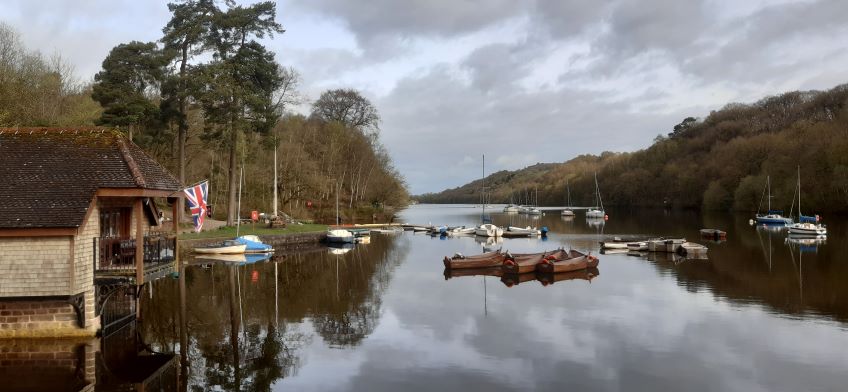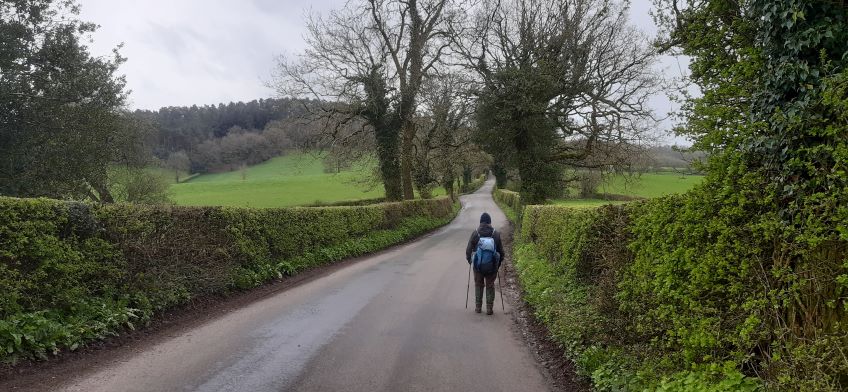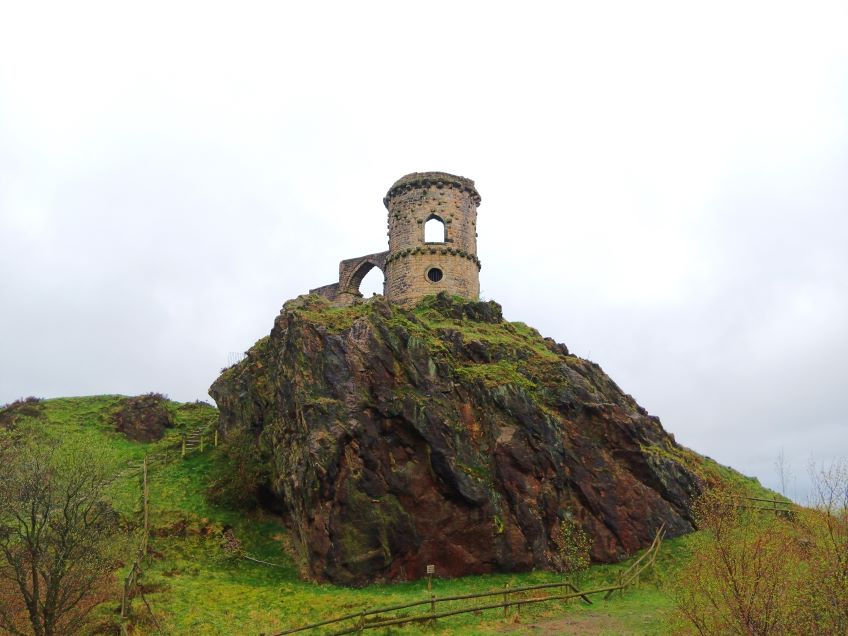“We are not fair- weather walkers,” my life-long trekking companion and poet Peter Gibbs and I have always said, but setting out on the Staffordshire Way cross country walk after weeks of April rain was to put that easy boast severely to the test!
After overnighting at the friendly Royal Oak in Biddulph, known as the garden town of Staffordshire thanks to its success in the Britain in Bloom competition, a taxi arrived promptly at 9am to take us up to the National Trust’s historic Mow Cop Castle.
This now dark and brooding and certainly atmospheric, lofty yesteryear folly, standing 355 metres above sea level, is the landmark start of this ninety-two miles national trail.
Wealthy local landowner Randall Wilbraham built it back in 1754 to enhance the view from his home at nearby Rhode Hall.
Close by is The Old Man of Mow, the name given to a curious pillar of rock which was left after quarrying around it.

Now the way heads off in a roughly north easterly direction sharing Cheshire County Council’s Gritstone trail for some six miles as far as The Cloud, a magnificent viewpoint with extensive views over the two counties.
Here our way descended steeply for six hundred feet to the River Dane, a tributary of the River Weaver which has its source in The Peak District and I took it particularly slowly having earlier lost my balance on a treacherously muddy downhill slope.
After following the old track bed of the Churnet Valley Railway, the way arrives at the picturesque Rudyard reservoir before turning off through woodland and eventually reaching The Rudyard Hotel.
Overlooking the water, it started life as a cluster of water bailiff’s cottages and was our overnight stop.
While the previous day we had walked under a combination of grey skies and the occasional sunny intervals, a steady drizzle greeted us early the following morning as we stepped out fully kitted in all our wet weather gear and descended to the reservoir.
Built in the 18th Century to supply water for The Caldon Canal, it is described as a hidden gem of the Staffordshire moorlands and attracts around 500,000 visitors a year.
Now reaching the dam wall, we began following this narrow feeder waterway as it made its way along the side of a long-wooded valley towards the canal.
This eighteen-miles waterway was opened way back in 1779 to link Etruria Junction on the mighty Trent-Mersey Canal in the Potteries town of Stoke on Trent with the small village of Froghall our destination for the night.
Its Fraggle Wharf was literally a hive of industry in times past, but this was here and now and following the narrow and very muddy path beside that small feeder waterway along this beautiful valley was proving extremely challenging.
Even with two trusty walking poles keeping one’s balance was not easy and I breathed a sigh of relief when we at last reached a gravelled section beside a small footbridge.
A few miles further on with the rain still falling, we came to Cheddleton, which caps a steep rocky spur overlooking the marshy valley of the River Churnet.
The canal reached here in 1779 and had an immediate effect on the village with the establishment of industries including a brewery and lime kilns, a boat building yard, and a paper mill along its banks.
We were definitely ready for a break, and our fingers were tightly crossed as we approached the aptly named Boat Inn and hoped that it would be open and luckily it was. They were not serving food, but happily allowed us to eat our sandwiches and even provided two plates.

Now followed a very muddy afternoon’s walk beside the canal as it wound its way through dense woodland along the valley of the River Churnet, passing some amazing old line kilns and a heritage railway enroute.
At last damp and muddy with waterlogged boots we reached journeys end in Froghall where the canal wharf had played a significant part in the limestone industry.
Here many thousands of tonnes mined in huge quarries nearby were lowered by tramway to the wharf and either burnt in kilns or loaded on barges and transported to the Potteries.
Our overnight stop was at the recently refurbished Railway Inn which we entered wearily to find a log fire blazing and a most welcoming mine host who found a tray box for our boots, while his wife made us a large pot of tea.
With more rain forecast and the prospect of yet another long day of muddy footpath walking on to Uttoxeter, we decided it was time for a change of plan and reached for our trusty OS Landranger map.
As luck would have it, we quickly spotted a direct route using only a series of linking quiet country lanes right across undulating open country with, as we were to discover, many fine views and rolling vistas of rural Staffordshire along the way.
Here are the highly descriptive poems that Peter, the author of the Amazon published anthologies Let the Good Rhymes Roll, wrote enroute and without falling over!
Mow Cop Castle
Stark in bleak chill landscape
Outlined ‘gainst grey-washed skies
The ruined Mow Cop castle
Looks out through sightless eyes
High upon its towering ridge
With Staffordshire below
As down through muddy woodland paths
The hopeful walkers go
A forecast with just constant rain
And early morning fears
Forgotten as the grey clouds part
And timid sun appears.
Sea Of Mud
When April heavens open
And rivers turn to flood
Towpaths on canalside
Become a sea of mud
Bootprints filled with water
Where others have passed by
Rippled by the raindrops
Reflecting leaden sky
But when the summer comes again
What beauty there will be
Consigning all these quagmires
To distant memory.
Hope Of Spring
Moss-covered stones a-tumbled
Alongside peaceful lane
That winds through quiet valleys
‘Fore climbing hill again
Trees with just a dusting
Of green from comìng leaves
As over rolling landscape
The hope of Spring now breathes
Hawthorn white in hedgerow
Wild garlic hidden where
Pure flowers will bloom in fine array
With scent to fill the air.




